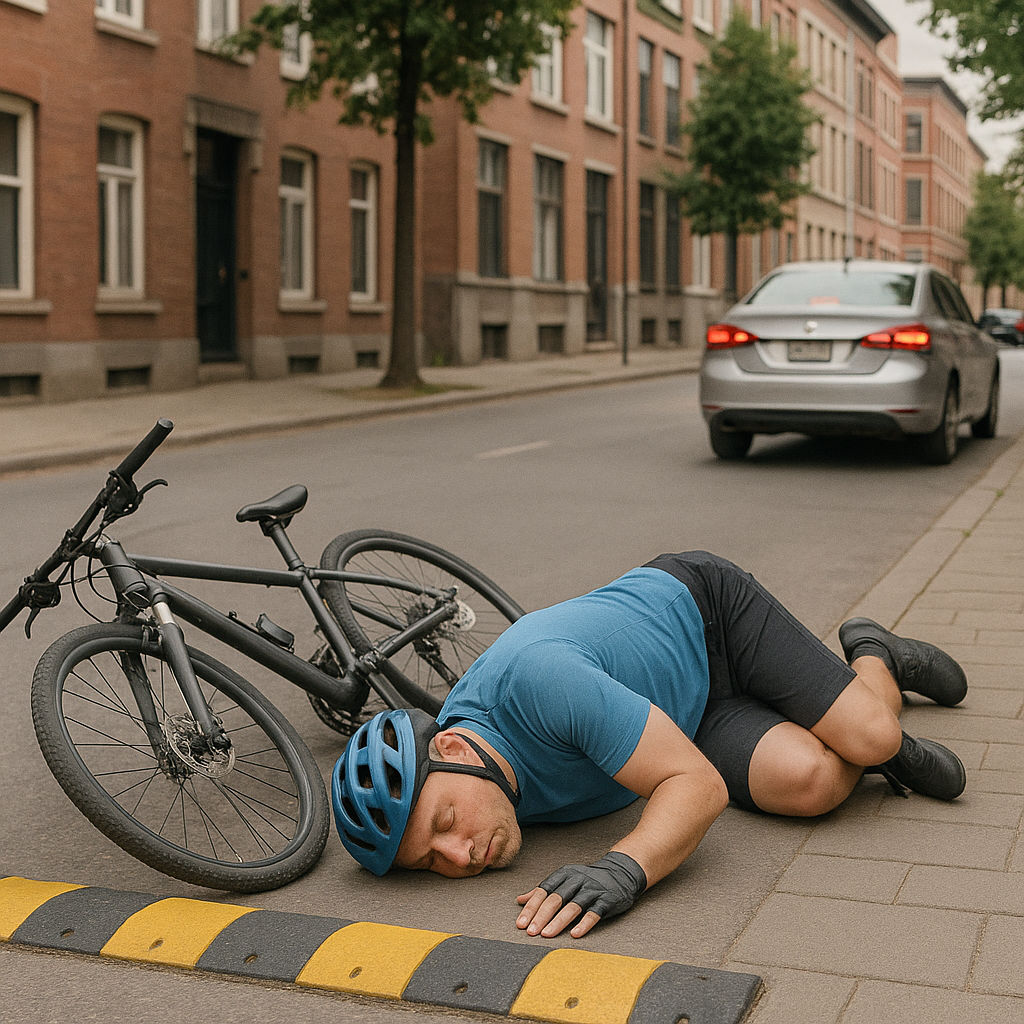Cyclist Dies While Trying to Avoid Speed Bump: When Road Safety Measures Turn Deadly

Article Description: Examining how speed bumps meant to protect can sometimes cause fatal bicycle accidents and what this means for cyclist safety.
Cyclists face a tricky paradox on roads designed to slow traffic. Speed bumps and other traffic calming devices aim to reduce vehicle speeds, making streets safer for everyone. Yet, these same measures can become hazards themselves, especially for cyclists. When a cyclist tries to avoid a speed bump, the sudden maneuver can lead to loss of control, crashes, or worse. This article explores the risks speed bumps pose to cyclists, the causes behind fatal bicycle accidents linked to these devices, and how road safety measures might be improved to prevent such tragedies.
Key Takeaway
- Speed bumps reduce vehicle speed but can increase cyclist fall risk if poorly designed or avoided abruptly.
- Most cyclist fatalities involve motor vehicle collisions, but road hazards like speed bumps contribute to accident severity.
- Better bicycle safety infrastructure and thoughtful speed bump placement are critical to reducing cyclist injury and death.
The Double-Edged Sword of Speed Bumps for Cyclists
Speed bumps have long been a staple of urban traffic calming. Their purpose is straightforward: slow down cars to prevent crashes and reduce injury severity. Studies show that speed bumps can cut crash rates by up to 40%, which is significant. (1) But for cyclists, these raised road features can be a hazard. Unlike cars, bicycles have less stability and smaller contact patches with the road, making them more vulnerable to sudden changes in surface elevation.
The Mechanics Behind the Hazard
When a cyclist approaches a speed bump, they face a choice: slow down and ride over it carefully or swerve around it. Swerving might seem safer to avoid the jolt, but it often leads to unexpected falls or collisions with vehicles or roadside obstacles. The abrupt steering changes required to avoid speed bumps increase the risk of losing balance, especially at higher speeds or on wet or uneven surfaces.
Even riding over a speed bump can be risky if the design is not bicycle-friendly. Sharp edges, steep inclines, or poorly marked bumps can cause the front wheel to catch or the rider to be jolted off balance. This is particularly dangerous for less experienced cyclists or those riding heavier bikes.
Case Studies and Statistics
While direct data on cyclist fatalities caused specifically by speed bump avoidance is scarce, broader bicycle accident statistics shed light on the problem. In 2022, the U.S. saw 1,105 cyclist fatalities, a 13% increase from the previous year. (2) Most of these deaths involved collisions with motor vehicles, but road hazards like speed bumps contribute to injury severity and accident risk.
Research indicates that poorly designed speed bumps and their placement in bicycle accident hotspots correlate with higher cyclist fall risk and injury severity. (3) Cyclists trying to avoid speed bumps may swerve into traffic lanes, increasing the chance of motor vehicle collisions. This interplay between traffic calming devices and cyclist vulnerability highlights a design challenge for urban planners.
How Road Safety Measures Can Backfire
Traffic calming devices, including speed bumps, are intended to protect vulnerable road users, but when they are not designed with cyclists in mind, they can create new dangers.
Design Flaws and Placement Issues
Speed bump design often prioritizes motor vehicles, neglecting the unique needs of cyclists. For example, bumps with abrupt edges or insufficient length force cyclists to slow dramatically or risk a harsh impact. Inadequate signage or poor visibility of these devices can catch cyclists off guard, especially at night or in bad weather.
Placement is another critical factor. Installing speed bumps on busy cycling routes without adequate bike lane protection forces cyclists to choose between riding over the bump or veering into traffic. This dilemma increases the likelihood of accidents.
The Role of Traffic Speed and Vehicle Size
Higher vehicle speeds increase crash severity for cyclists. Speed bumps reduce vehicle speed, which is beneficial overall. But if cyclists must suddenly avoid a bump, the risk of falling or colliding with a motor vehicle rises. Larger vehicles, which take up more road space, leave less room for cyclists to maneuver safely around speed bumps.
Cyclist Behavior and Avoidance Maneuvers
Cyclists often try to avoid speed bumps by swerving or braking hard. These maneuvers can lead to loss of control, especially if the cyclist is inexperienced or riding in poor conditions. Sudden braking may cause rear-end collisions with following vehicles, while swerving can put cyclists into the path of oncoming traffic.
Improving Bicycle Safety Infrastructure Around Speed Bumps
To reduce cyclist injury and fatality risk, road safety measures need to be adapted to better accommodate cyclists.
Bike-Friendly Speed Bump Designs
Some communities have experimented with speed bumps designed specifically for bicycles. These might include:
- Rounded or elongated bumps that reduce jarring impacts.
- Gaps or channels allowing cyclists to pass smoothly without swerving.
- Clear markings and warning signs visible to cyclists and drivers alike.
Such designs maintain the traffic calming benefits while minimizing hazards for cyclists.
Enhanced Signage and Lighting
Warning signs placed well before speed bumps give cyclists time to prepare to slow down or adjust their path safely. Reflective paint and lighting improve visibility at night, reducing surprise encounters.
Protected Bicycle Lanes and Alternative Traffic Calming
Where possible, protected bike lanes separated from vehicle lanes allow cyclists to avoid speed bumps altogether. Alternative traffic calming measures such as chicanes, curb extensions, or raised crosswalks can reduce vehicle speeds without creating obstacles for cyclists.
Education and Awareness
Educating cyclists about the safest ways to approach speed bumps and encouraging drivers to respect cyclists’ space can reduce accidents. Awareness campaigns can highlight the risks of abrupt avoidance maneuvers and promote helmet use and defensive riding.
The Broader Context of Urban Cycling Dangers
Speed bumps are just one piece of the puzzle. Urban cycling involves multiple hazards:
- Motor vehicle collisions remain the leading cause of cyclist fatalities.
- Poor road conditions, distracted or impaired driving, and inadequate lighting increase accident risk.
- Lack of consistent bicycle safety infrastructure leaves cyclists vulnerable.
Addressing these issues requires coordinated efforts between city planners, traffic engineers, law enforcement, and cycling advocates.
Practical Advice for Cyclists Facing Speed Bumps
Cyclists can take steps to reduce their risk when encountering speed bumps:
- Slow down well before the bump to maintain control.
- Ride straight over the bump rather than swerving.
- Use bike lanes or paths that avoid speed bumps when available.
- Wear a helmet and protective gear to reduce injury severity.
- Stay visible with lights and reflective clothing, especially at night.
- Be alert for traffic and road conditions around speed bumps.
FAQs
How common are speed bump cyclist accidents, and what do bicycle accident statistics 2022 show about cyclist fatality rates?
Speed bump accidents involving cyclists happen more often than many people think. (4) Recent bicycle accident statistics show that cyclist fatality rates have been rising, with bicycle fatality increasingly becoming a serious concern. Many cyclist deaths occur when riders try dangerous cyclist avoidance maneuvers around traffic calming devices. Bicycle crash statistics reveal that urban cycling dangers are growing, especially in areas with poor speed bump placement and inadequate bicycle safety infrastructure.
What makes speed bumps such a significant road hazard for cyclists, and how do they contribute to cyclist injury severity?
Speed bumps create a major road hazard for cyclists because they force sudden changes in riding patterns. When cyclists encounter a speed bump hazard, they often swerve into traffic lanes, increasing cyclist vulnerability to motor vehicle collision. The cyclist’s fall risk increases dramatically during these maneuvers. Poor speed bump design can turn helpful traffic calming devices into deadly obstacles, contributing to fatal bicycle crashes and serious cyclist injury. (5)
How effective are current road safety measures and traffic calming effectiveness when it comes to pedestrian and cyclist safety?
While road safety measures like speed reduction measures help control vehicle speed impact, they can create unintended consequences. Traffic calming effectiveness studies show mixed results for cyclist safety. Some traffic calming devices reduce urban traffic fatalities overall, but cyclist accident hotspots often develop around poorly designed infrastructure. The challenge is balancing speed limits with bicycle lane safety and ensuring cyclist road sharing works safely.
What are the main cyclist death causes and cyclist crash causes that lead to bicycle accidents with motor vehicles?
Major cyclist death causes include cyclist collision with cars, often triggered by cyclist avoidance maneuvers around obstacles. Common cyclist crash causes involve distracted driving, impaired driving, and poor lighting conditions during nighttime riding. Multi-lane roads pose special risks, as do areas where bicycle safety infrastructure gaps force cyclists into dangerous situations. Vehicle speed and road conditions also play major roles in cyclist accident risk factors.
What can cities do to improve cyclist accident prevention and reduce bicycle accident injury types?
Effective cyclist accident prevention requires better bicycle safety infrastructure and smarter traffic speed limits. Cities need comprehensive cyclist accident analysis to identify cyclist accident hotspots and address bicycle safety infrastructure gaps. Installing proper speed bump warning signs, improving bicycle lane safety, and implementing cyclist accident risk mitigation strategies can help. Bicycle safety advocacy groups push for better cyclist accident prevention tips and improved road design.
How do cyclist accident trends and bicycle accident injury severity compare across different road conditions and infrastructure types?
Cyclist accident trends show that bicycle accident injury severity increases on roads with poor infrastructure and high vehicle speeds. Areas with inadequate bicycle safety infrastructure see more serious cyclist injury and higher rates of cyclist accidents with motor vehicles. Road design affects cyclist accident risk factors significantly. Studies of cyclist accident case studies reveal that proper infrastructure reduces both cyclist accident liability issues and the severity of bicycle injury treatment needs.
What should someone do immediately after witnessing a bicycle accident, and how important is cyclist accident reporting?
Quick cyclist accident emergency response can save lives and improve bicycle accident survival rates. Call emergency services immediately and provide accurate cyclist accident reporting to authorities. Proper reporting helps with cyclist accident analysis and can prevent future incidents. Emergency responders need training in bicycle injury treatment since cyclist injury severity can be deceiving. Good accident reporting also helps with any bicycle accident legal issues that may arise later.
What role do cyclist helmet safety and other bicycle accident prevention strategies play in reducing cyclist accident statistics in the USA?
Cyclist helmet safety significantly reduces head injury risks, though it doesn’t prevent all types of bicycle accident injury types. Comprehensive bicycle accident prevention strategies include better lighting for nighttime riding, following bicycle safety regulations, and understanding cyclist accident risk mitigation techniques. While helmets help with cyclist accidents and speed-related injuries, they can’t solve problems caused by poor bicycle safety infrastructure or dangerous cyclist accidents and road design combinations.
Conclusion
Speed bumps and traffic calming devices undoubtedly save lives by slowing vehicles. But their design and placement must consider cyclists’ unique vulnerabilities. When cyclists try to avoid speed bumps abruptly, the risk of fatal bicycle accidents rises. Thoughtful infrastructure improvements, better signage, and education can help ensure traffic calming measures protect all road users without creating new hazards. The challenge lies in balancing vehicle speed reduction with safe, accessible routes for cyclists. Only then can road safety measures truly serve their purpose without turning deadly.
References
https://www.bikelegalfirm.com/2022-cyclist-deaths-statistics
https://injuryprevention.bmj.com/content/29/1/68
https://bikeleague.org/highest-ever-reported-number-of-people-killed-while-biking-in-2022/
https://www.speedhumpsaustralia.com.au/pedestrian-and-cyclist-safety/
https://williammattar.com/practice-areas/bicycle-accident/bicycle-speed-bump-accident/
Call Now or USE contact form a for same-day response:







★★★★★ Excellent Speeding Ticket Lawyer – Joseph is the Best!
I hired Joseph to help with a speeding ticket that could’ve seriously impacted my driving record. From our first conversation, he was professional, calm, and clearly experienced with traffic cases.
Joseph took care of everything — paperwork, court appearances, and negotiations — and got my fine significantly reduced with no points on my license. He kept me informed every step of the way and explained the legal process in a way that was easy to understand.
If you’re looking for a traffic attorney who truly knows what he’s doing, I highly recommend Joseph. He’s sharp, responsive, and gets results. 5 stars all the way!



Throughout The process kept me informed, & answered all my questions ; His dedication to his clients is really really Impressive.
